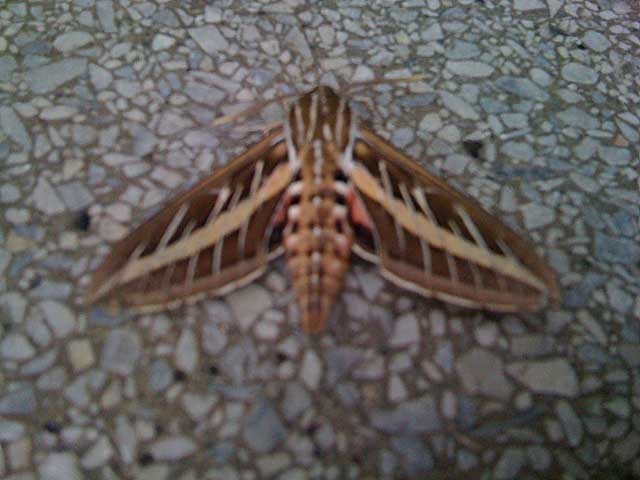San Francisco County
Sphingidae

|
|
Created/dedicated as per personal comunication with Allison Rung, August 2010 Updated as per James P. Tuttle's The Hawk Moths of North America, August 26, 2010 Updated as per Butterflies and Moths of North America, formerly USGS, August 2010 |

Allison writes, "I found your website address on whatsthatbug.com, where I learned that the moth I found on my front steps last week (August 20) is a white-lined sphinx! I attach a photo though I regret its quality is poor. I think this specimen may have been sick, because it readily crawled into my palm, and seemed to be fluttering nervously as I transferred it to a place where it was less likely to get crushed underfoot.
"I read on your site that this isn't a rare species, but I thought this sighting might be of interest to you. Is it? Thanks for the site."
I replied, "I am interested in all sightings of Sphingidae with images and data (date and location). This species has very strong migrating tendancies, and may have been worn out after a long flight, or it may have still been mesmerized by lights that attracted it during the night. Sometimes the fluttering is an attempt to raise body temperature in preparation for flight. If you were having an unusualy cool morning, maybe it was thermoregulating."
It is hoped that this checklist, with the thumbnails and notes, will help you quickly identify the moths you have encountered.
A WO" after the species name indicates that I have no confirmed reports of this species in San Francisco County, but I (William Oehlke) expect that this moth is present.
A USGS indicates the moth is reported on the USGS website and/or in Moths of Western North America, #2. Distribution of Sphingidae of Western North America, revised, an excellent little booklet available through Paul Opler.
Please help me develop this list with improved, documented accuracy by sending sightings (species, date, location), preferably with an image, via email to Bill Oehlke.
Sphinginae subfamily
Smerinthini Tribe:
Macroglossinae subfamilyDilophonotini Tribe:
Philampelini Tribe:
Macroglossini Tribe:
|
Enjoy some of nature's wonderments, giant silk moth cocoons. These cocoons are for sale winter and fall. Beautiful Saturniidae moths will emerge the following spring and summer. Read Actias luna rearing article. Additional online help available.
Use your browser "Back" button to return to the previous page.
This page is brought to you by Bill Oehlke and the WLSS. Pages are on space rented from Bizland. If you would like to become a "Patron of the Sphingidae/Catocala Sites", contact Bill.
Please send sightings/images to Bill. I will do my best to respond to requests for identification help.
 Show appreciation for this site by clicking on flashing butterfly to the left. The link will take you to a page with links to many insect sites. |